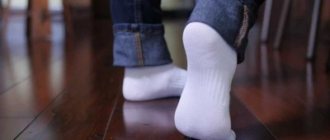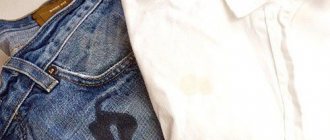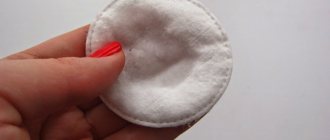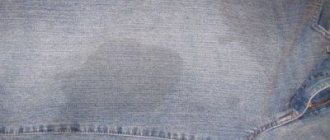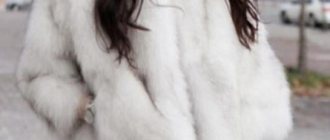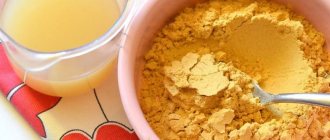In addition, one should take into account the peculiarities of processing such marks and the presence of a number of prohibitions.
For more information on how to remove blood (fresh, dried, old) from clothes at home, and what water to treat the fabric in, read the article.
Fresh spots
The effectiveness of washing depends very much on how much time has passed since the stain appeared and on the type of fabric. The faster you start removing traces of blood, the better the result will be.
A simple stain removal option:
Hold the affected area under cold running water.- Fill a basin with cold water.
- Dilute the detergent.
- Rub the damaged area of the material with laundry soap.
- Soak the item for 30-40 minutes.
- Extend.
- Rinse.
The complexity of blood stains lies in the protein and hemoglobin they contain. The protein has the property of coagulating when exposed to temperature, and iron from hemoglobin in the blood gives the stain a reddish tint, which is difficult to remove.
How to wash blood in a machine, functions, temperature, soaking
Before using the machine, you should try to wash off protein stains with cold water with your hands. From a hot liquid, the substance will simply coagulate and penetrate the material even more strongly. This is especially true for white linen. Then treat the area with laundry soap and leave for half an hour.
Advice! If after hand washing the blood traces do not disappear, combine methods: rinse, soak, hand wash, then put in the machine. If you add a soaking mode at a low temperature, the result will be positive.
How to wash dried blood in a machine: set it to 30-40 degrees, and add a little salt, ammonia or stain remover for colored or white laundry to the powder. Some types of washing machines include an additional function - stain removal.
You should put things less than the permissible weight. For white laundry, use bleach; for colored laundry, use gentle chemicals.
Old, dried out
Traces of blood that have already dried will be much more difficult to remove. If the recipe you are using does not help, you can use another one.
It is advisable to start processing by soaking the entire item in cold water . This technique will prepare the fabric for further processing.
For relatively fresh stains, it is enough to keep the clothes in water for an hour, for old traces of blood (if the type of fabric allows) - longer, 2-3 hours.
If, after soaping with Antipyatin or laundry soap, the stain does not go away completely, proceed to removing the marks using one of the recipes.
Dishwashing gel
Shampoo or dish soap can be used to remove stains if nothing else is available and the stain is not yet old.
To do this , moisten the material, apply the selected preparation and rub gently . After 10 minutes, wash and rinse the item.
Another way is to apply undiluted dishwashing gel directly to the stained area of the material. Apply liberally, not in a thin layer.
After this, cling film is placed on top and left in this form for a couple of hours or even more, up to five. After this, the product is washed.
Hydrogen peroxide
White items can be treated with hydrogen peroxide, but only if the material is natural (cotton, linen) and dense.
Stain removal procedure:
- Use a bottle of peroxide to pour over the stain. Or treat it using a sponge.
- Allow time for the chemical reaction to take place.
- Wash the item.
You can enhance the effect if you add ammonia to the peroxide. These liquids should be combined in equal proportions.
This method is only suitable for fairly dense fabrics and is not recommended for delicate ones.
Salt
To remove a stain, you need to prepare a solution:
pour 3 liters of cold water into a basin;- add 60 grams of salt;
- stir;
- dip soiled clothes;
- leave for 6-8 hours;
- wash with Antipyatin or laundry soap;
- rinse.
For delicate fabrics, the option with salt is undesirable.
Soda
Removing stains with soda is carried out according to the following method:
- Pour 1 glass of cold water into a container.
- Pour 10-15 grams of soda into it.
- Stir.
- Pour the solution onto the mark.
- Leave for 30 minutes.
- Rub the dirty area.
- Wash the item using detergent.
The recipe is designed for thick fabric.
Ammonia
Ammonia allows you to remove blood from clothes, sheets and other soiled items made from linen or cotton.
Procedure:
- pour 3 liters of water into a basin;
- pour in 60 ml. ammonia;
- soak the thing;
- keep in the solution for a couple of hours.
Potato starch
For thick cotton and linen fabrics, you can use almost any of the recipes, but for delicate items you need to proceed differently:
- Pour ½ cup of starch into a container.
- Add a little water to form a paste.
- Apply the mixture to the fabric.
- Set the item aside for the time necessary for the paste to dry completely.
- Clean any remaining slurry from the material with a dry cloth or towel.
- Wash the product.
Vinegar
Table vinegar, thanks to the acid it contains, can be a good stain remover. A local stain can be treated with undiluted liquid and left for half an hour.
If there are several stains in different places, then it would be better to prepare a solution of two parts water and one part vinegar . The item is completely dipped into it and left for 10-15 minutes, after which it is washed.
For vinegar to be 100% effective and completely remove stains, it should be used within the first 24 hours after the mark is formed. After this period, acetic acid will be less effective.
Glycerol
Glycerin is often used to remove stains. For the best effect of the manipulation, the bottle with glycerin should be warmed up a little so that it becomes warm.
Using a cotton swab, treat the blood stain while the glycerin is still warm. After removing the stains, the item is washed and rinsed.
Lemon and salt
Lemon juice is a natural product that helps in removing a variety of stains. Citric acid, like acetic acid, can also cope with blood stains.
For cleaning, prepare the following mixture:
- in a container mix 2 tbsp. l. lemon juice and 1 tbsp. l. salt;
- Using an old toothbrush, treat the fabric;
- Rinse the material with cold water.
The disadvantage of this method is its relatively low effectiveness against large or old stains. And the impossibility of using on colored fabrics.
How to remove fresh blood stains from clothes
To remove blood from clothing, you need to act quickly. After all, stains are easier to wash off before they dry. You can get rid of contamination so that no traces remain by following the diagram:
- The bloody stain is washed off from the back and front sides of the material with cold water, simply directing the stream with strong pressure to the problem area. This is done until the stain lightens.
- The soiled item is soaked in ice water (you can add additional ice to the basin) for 2 hours. The water is changed every 30 minutes. During the last soaking, add washing powder to the water.
- If the stain does not disappear after previous procedures, rub it with laundry soap, dishwashing detergent or stain remover. The material is left for another 3–4 hours.
- To get rid of residual contamination, use ammonia.
The resistance of blood stains is ensured by the protein component and iron. Protein (hemoglobin), upon prolonged contact with air, coagulates and is tightly embedded in the structure of the material. Iron acts as a permanent dye.
Handwash
After soaking, the blood can be easily removed by hand washing. The fabric is washed in a soapy solution, paying attention not only to the stain, but to the item as a whole. Then rinse thoroughly in plenty of cold water.
Machine washable
If, after preliminary procedures, the soiled item is washed in a machine, then use water with a temperature of no higher than 30 degrees. After washing clothes, use an additional hand rinse.
See general rules:
Top 3 household chemicals
In addition to home recipes, household chemicals can be used. These include modern stain removers in various forms (from liquids to powders and pencils).
The principle of operation of the stain remover is a chemical reaction in which foam can even form . While this effect remains, you should not wash off the cleanser.
Special stain remover Dr. Beckmann
This well-known product is designed to remove not only blood stains, but also other protein-based contaminants.
The stain remover is available in liquid form and has an active formula that is effective against a wide range of stains. A 50 ml bottle costs from 200 rubles.
Using the stain remover is very simple:
- Apply the product to the blood.
- Leave for 5 to 10 minutes.
- Wash as usual.
Flaws:
- small volume;
- high price;
- inconvenient to dose;
- For older stains, re-treatment may be necessary.
Spray Amway SA8
This spray is intended for pre-treatment of stains before washing. Bottle volume - 0.4 l. Price – from 600 rubles.
The product has a pleasant citrus aroma and is easy to apply to the desired location. The solvents included in the composition are highly active against various stains, including blood.
Application:
- Spray onto the stain from a distance of 0.15 m.
- Wash as usual.
Flaws:
- not always effective for old stains;
- high price.
Vanish Gold Oxi Action
Liquid stain remover is available in varying volumes. Minimum – 0.1 ml. Price -160 rubles for 0.45 l.
The gel is produced separately for white items, and separately for colored items. Can be used for soaking, removing local stains and as a means of enhancing the effect of regular washing powder.
Stain Treatment:
- Apply the product to the stained area undiluted.
- Rub a little.
- Measure a portion (1 measuring cap) and add to the powder when washing in the machine.
How to remove old blood from bed linen?
How to remove old blood from bed linen so you can preserve it and not throw it away. Often, even after attempts to erase traces of blood, yellow spots may remain, which spoils the appearance of the product. Today we will learn several ways in which you can remove old blood stains from bedding.
Old blood stains are not easy to remove. To remove this type of stain, you can use folk remedies, or you can take advantage of the achievements of the chemical industry. You need to be careful when bleaching bed linen made of poplin and satin; we already know what kind of material poplin is for bed linen; to bleach such fabrics, you need to carefully read the manufacturer’s instructions. In this article, we will look at what chemicals to use to remove old blood stains on bedding.
The first in our rating is whiteness, an inexpensive but effective product. If the bed linen is cotton and not colored, you can use white, just remember that after the linen has been in the solution with white, you cannot wash it with colored fabrics the first time after soaking.
You can dilute the white in water and immerse the laundry, leave for twenty minutes, and then additionally wash the stained area with laundry soap. You can pour white over the dirt and leave it for 20-30 minutes.
Considering that the laundry is white, it is better to soak it completely in a bleach solution, this will help make the white color fresher and cleaner. Honestly, if a stain really spoils the appearance, it’s easier to buy one-and-a-half bed linen, the cost of which is now very reasonable. When hardening an old blood stain from bed linen in a bleach solution, it is better to use gloves; bleach has a bad effect on the skin of your hands, drying it out, and besides, the smell of bleach cannot be removed from the skin immediately.
The second product that can be used to remove old blood stains from bed linen is the well-advertised vanish. This product has several types, so it can also be used for colored linen, unlike white, which we use only for white cotton fabrics.
The dirt should be rinsed in water and then soaked in the product. Then you can wash your laundry in the machine using vanish. Vanish for colored fabrics can also be used for CPB made of polysatin; we have already read reviews on bed linen made of polysatin. This fabric is suitable even for allergy sufferers, but when using bleach, it is better to carefully read the instructions.
You can use Antipyatin, this product is sold in the form of soap and liquid. It should be used in the same way as vanish; after treatment, it is also necessary to wash the bed linen in the washing machine.
Features of removing stains from various fabrics
Not all fabrics respond equally to blood stain removal recipes :
- thin and delicate materials should not be exposed to acids and alcohols;
- dense materials (for example, jeans) are difficult to clean from stubborn stains due to the way the fibers are interwoven;
- white dense natural materials make it possible to actively remove stains by alternating recipes.
Cotton and linen
Most cotton and linen textiles respond well to stain removal. If the material is dense and white, then you can not be afraid to use either vinegar, ammonia, or professional stain removers.
Jeans
You can try to clean denim material with dishwashing detergent diluted in water . For convenience, it is better to use a toothbrush to rub the stain.
By doing this, it is more convenient to get to the fibers of the material. After treatment, the jeans will need to be rinsed.
If the method does not help much, you can use a recipe based on starch or soda . Do not rub the stain vigorously - the fabric may become discolored. The same problem can occur when exposed to vinegar or alcohol, especially over a long period of time.
Restrictions on the use of peroxide and vinegar do not apply to white jeans - they can be used.
Read more about fighting blood on denim here.
Delicate materials
Delicate materials, even white ones, require careful handling . If you can’t wash off the blood right away, it will be difficult to remove the stain, since most recipes are not suitable. It is possible to use only non-aggressive drugs, for example, starch.
It is better to test store-bought stain removers on an inconspicuous small area before using them on a stain.
Features of removing blood stains from white fabric
Removing blood stains from white fabric is prohibited in hot water because the blood begins to coagulate and tightly adhere to the fibers of the fabric. If the stain is old, wash it in warm water; if it is fresh, wash it in cold water. It is best to remove the blood before it dries. In this case there will be no difficulty. Once the stain has dried, you can’t do without special products.
You need to wipe away dirt using blotting movements and do not rub under any circumstances. This will help avoid divorces. In addition, intense friction can force blood deep into the fibers, making further cleaning difficult. If the stain is fresh, just rinse it under running cold water. If it’s old, soak it for several hours with one of the homemade removal products.
Before you start washing blood from white clothes, you need to choose a product based on the type of fabric. For example, gasoline and solvents are not suitable for synthetics; they will kill the product. If we are talking about ready-made stain removers that are sold in stores, then you should read what fabrics they are intended for.
Do not use chlorine-containing products, such as bleach. They can remove even the brightest stains, but there is a risk of leaving a yellow stain and ruining the fabric.
Prohibitions and restrictions
There are many ways to remove stains, allowing you to choose the most suitable one. It must be taken into account that deviations from time-tested methods may not only not help, but also have the opposite effect.
The prohibitions include the following:
Do not use hot water to remove stains. This is due to a protein that is part of the blood, which has the property of coagulating under the influence of high temperatures. In this case, the blood is retained and not removed.- Do not rub a fresh stain so as not to smear it even more. Better to just get wet.
- If you don’t have time to soak and wash, you can apply the stain remover to the stained area, and after 10-15 minutes send the item to be washed in the machine. In this case, it is necessary to ensure that the water temperature is below +30ºС.
- If the fabric is delicate, then vinegar and ammonia should not be used without first testing on an inconspicuous area.
- Solvents such as acetone or white spirit should not be used.
If you are not sure about the safety of a particular stain remover, it is advisable to avoid using it so as not to completely ruin the item.
Recommendations
Simple methods will help you remove blood stains from clothes. In addition to using recipes, you should follow these tips:
When removing blood stains, you should wear rubber gloves to protect your hands from exposure to chemicals.- If time was lost, the stain dried out, and then it was also processed incorrectly, the blood protein coagulates.
It will be extremely difficult to remove such contamination. As a last resort, if all resources have been exhausted, use intensive machine washing. However, the result is not guaranteed. - Even for white fabrics, you should not be too zealous with the use of stain removers, since they not only have bleaching properties, but also thin the material itself.
- Preparations with chlorine worsen the condition of the tissue and have an insidious quality - they leave the outline of the stain visible after removing it.
- Industrial stain removers have different instructions, so be sure to read them.
Stain removal options can be used one at a time, but not simultaneously, mixing a variety of ingredients in a row.
You will find maximum useful information about washing clothes and various fabric products here.
General recommendations for removing blood stains
We provided general recommendations for removing stains of various origins in this article. They need to be taken into account.
- ALWAYS test the product on a small piece of fabric, preferably on the hemmed bottom of the product;
- First, remove the stain, and then put the item in the washing machine;
- Do not rub a blood stain, old or new;
- Use cold water for washing and drying;
- For the same reason, do not iron fabrics with blood stains that have not been washed off: exposure to high temperatures will “fix” the stain on the fabric and it will be almost impossible to remove it;
- Apply the stain from the edges to the center to avoid light brown borders.
If the item is expensive, it is better not to even try to remove blood stains (especially old ones) on your own, but to immediately take the item to the dry cleaner.


